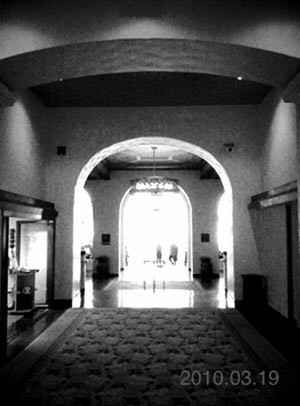
This is all you get. Full-size output from one of the recent super-low res camera apps (300x400 pixels)
Another day, another super-low-res monochrome camera is released in the App Store.
With the number of monochrome camera apps that save at the iPhone’s full resolution — Vint B&W, Spica SuperMonochrome, and others — and the number of apps that do an excellent job of converting images to monochrome — CameraBag, MonoPhix, CameraKit — I don’t understand why it’s suddenly become so difficult to produce apps that save to at least 1200×1600 resolution.
One of my biggest peeves in the App Store is the recent glut of super-low-res photo apps. These are the apps that save images at 320×480 pixels (or less) — the iPhone’s screen resolution. Seriously, that’s 0.154 megapixels. The original VGA resolution from the late 1980’s was 640×480 pixels.
An app that saves at 320×480 is nearly useless in my opinion. Don’t think you need more pixels that that? Your 320×480 images will look horrible on an iPad. You can forget about prints. A 320×480 pixel image will only make a print that’s about 2″ x 3.25″. That’s pushing it and it will still be fuzzy.
They won’t look much better on your monitor. Super-low-res images lack detail and sharpness no matter where they’re viewed. They simply don’t have the pixels to hold detail.
These super-low-res images are only good enough to send MMS phone-to-phone or to make wallpapers for your iPhone. They aren’t even large enough to look good online in Facebook, Flickr or Picasa.
If all of these other apps have been able to save 2MP files since the dawn of the App Store, why has it now become so hard to desaturate an image in full-resolution?
Why are these apps even released? In the comments section below, I welcome responses from developers who create super-low-res apps. I’m willing to have an open-minded debate on any merits of 320×480 apps.
Granted, sometimes an app’s goals overreach what the OS will let it do. For instance, last year I discovered an app which emulated a slow shutter time, creating some great motion effects. This was a very innovative camera app. At the time, there was nothing even comparable. Unfortunately, it saved at super-low-resolution. Apple doesn’t allow developers to tinker directly with the shutter speed of the iPhone. The developer told me how their app worked, but that saving at higher resolutions wasn’t possible, saying “I know well the output resolution is too low. However, I cannot do it for the life of me.” I felt sorry for this developer. But, they were honest and upfront in the description about the limitations of the app.
Many times, though, I think it’s just lazy programming. For example, there are dozens of full-resolution cameras already available that can shoot in monochrome. A noise reduction blur has been available in PhotoForge for a long time and the app is able to save any image size your iPhone’s RAM can handle. Apps like TiltShift Generator and FocalLab have been in the app store for a while; they have great focus tools and they save in full-res. I can’t imagine that those APIs are restricted from developers.
Some developers even charge a buck or two for apps that destroy your image size. What angers me the most is when a developer describes their app and everything it does, yet they leave out the very critical fact that the app only saves at 320×480 from the app’s description. With a 5 megapixel iPhone rumored to be released later this year, I think it’s both deceptive and irresponsible to omit this information from an app’s description.
I have much more respect and much less anger towards a super-low-res photo app that clearly states what its maximum resolution is. Then the choice is mine whether I want to spend money, time, bandwidth or all three on an app that produces tiny photographs which are only suitable for texting.
As a buyer, I want to know what I’m getting before I purchase. Without full disclosure, these camera apps aren’t a purchase, they’re a gamble. This not only irritates me when I get a clunker, but it erodes the confidence I have as a consumer in the App Store. While I realize that it’s only a dollar, when enough people unwittingly buy these apps, it’s rewarding lazy or deceptive behavior.
Ideally, it would be nice if every app that wasn’t full-resolution had the resolution information stated in its description. As long as people can be duped into spending a buck for a sub-par app, I don’t think this will ever completely happen.
It would be nice if Apple were to require this information to be disclosed the app’s description, but this would require additional testing on the part of Apple to ensure compliance and would increase the time from an app’s submission until its release. Apple has steadily been trying to reduce the submission-to-store time.
As consumers, all we can do is to be careful. Read the online app reviews here and at other iPhoneography web sites. Read the App Store reviews. Lately, it seems that reviewers have been very diligent at exposing these unannounced low-res apps in their reviews.
Developers, trust us to purchase your apps. Be honest with us up front. Don’t surprise us. Sure, you’ll lose sales, but you’ll generate far fewer complaints, one-star reviews and ill will if we purchase your super-low-res apps with our eyes wide open.
</rant>
=M=
~~~~
